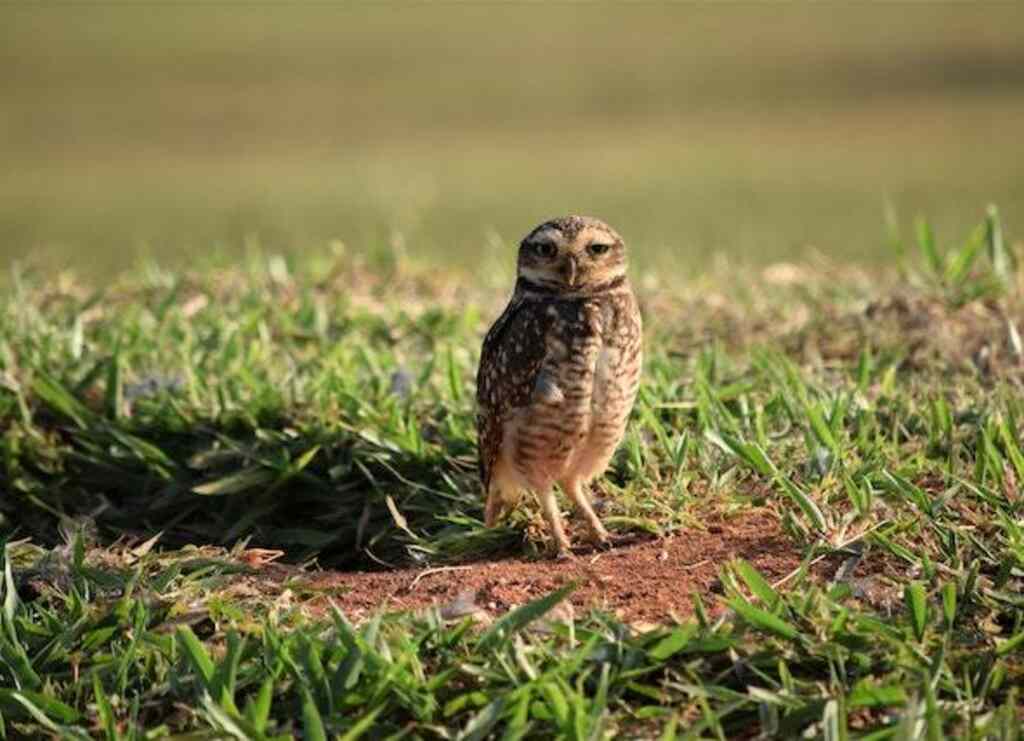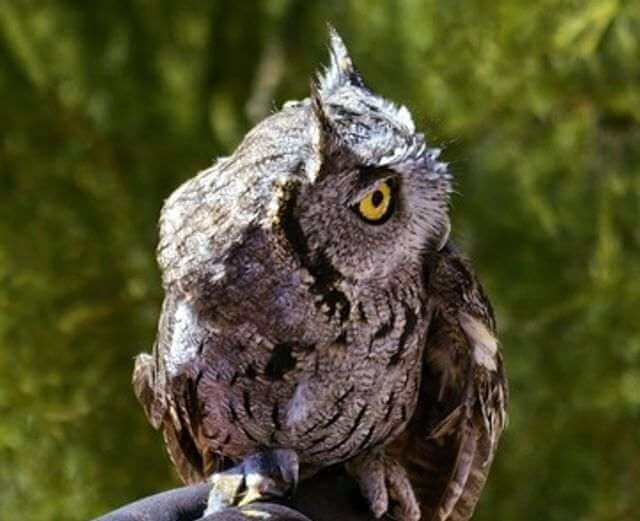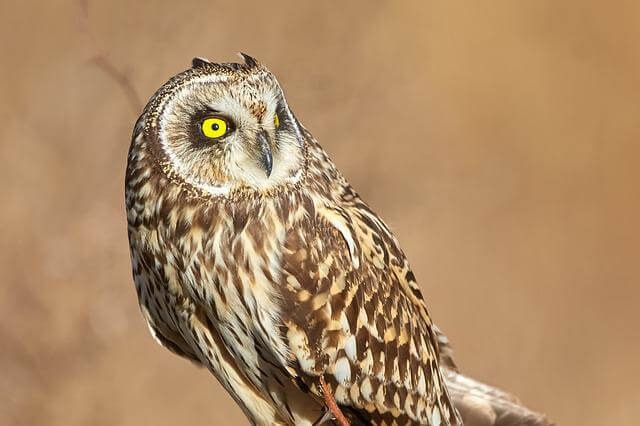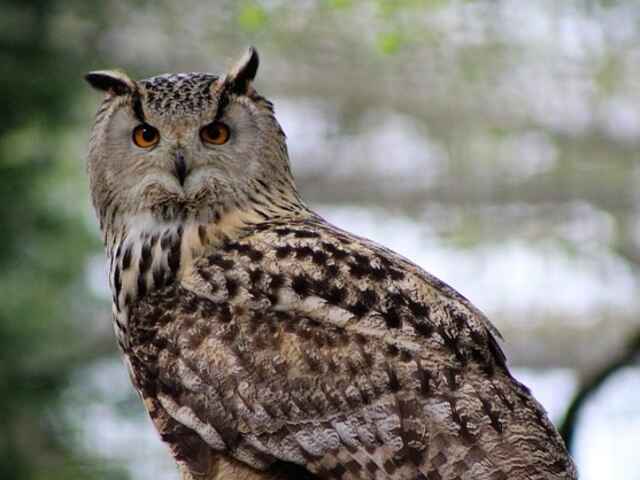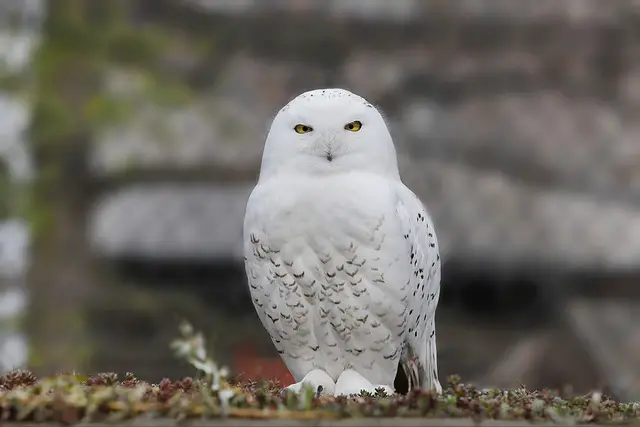Curious to discover the winged wonders of Utah? Get ready to be amazed by the diverse array of owls that call this state home! Look no further; this comprehensive guide will show you exactly what types of owls are living in the state for 2023.
From the Great Horned Owl to the Great Gray Owl, there is an impressive selection of owls to discover and learn about. With detailed descriptions and pictures, this article provides a full identification guide for all 14 owls in Utah.
Table of Contents
Types of Owls in Utah
Great Horned Owl

- Length: 18.1-24.8 in (46-63 cm)
- Weight: 32.1-88.2 oz (910-2500 g)
- Wingspan: 39.8-57.1 in (101-145 cm)
- Scientific Name: Bubo virginianus
- Frequency of Occurrence: 2.69% (Statistic by: eBird)
- Maps: Range Map – Sightings Map
- Sounds: Calls and Songs
- Where To Find Them: Utah’s forests provide prime real estate for these fantastic birds! In particular, mountain ranges like the Wasatch and Uinta Mountains offer plenty of perches for hunting. Along with trees that provide shelter and safety from predators, these areas also contain an abundance of smaller mammals—the owls’ favorite food source!
- How to Attract: First, start by designing an owl-friendly landscape with plenty of trees and shrubs that provide cover, resting perches, roosting sites and nesting areas for night hunters like owls. Plant native vegetation as much as possible and leave dead or broken branches in trees for perching spots. Second, install bird baths or ponds near tall trees or near your house to offer additional water sources for drinking and bathing during hot summer days. Finally, make sure to keep cats indoors at all times since they are one of the biggest threats to small raptors like owls.
General Information: Great Horned Owls are mysterious birds of the night, and with their imposing size and piercing gaze, they can be quite intimidating. These magnificent avian creatures live in a variety of habitats around the world, from dense forests to open fields. A Great Horned Owl’s range is determined by its diet; these birds of prey prefer to dine on small mammals like rabbits, mice, skunks and moles.
They will also feast on snakes, amphibians and fish when given the opportunity. Occasionally they will even eat other birds or smaller owls if food is scarce! Great Horned Owls build nests near rivers or streams to help provide them easy access to water for drinking and bathing. They use natural cavities in old trees as nesting sites; however, they are also known to take over nests abandoned by other large birds such as hawks or crows.
Read more: 35 Fun Facts About The Great Horned Owl (Detailed)
Burrowing Owl
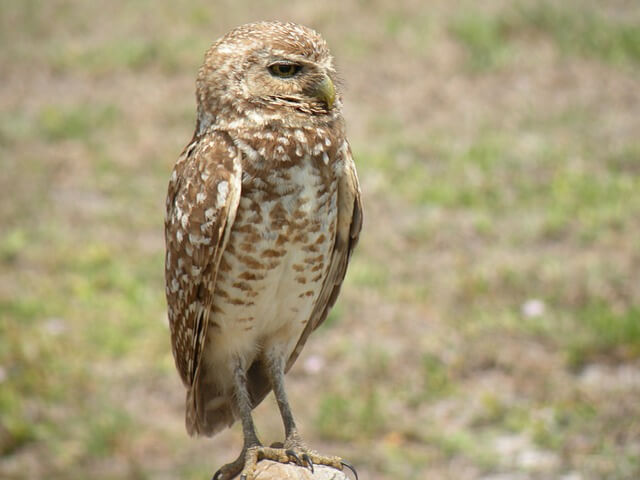
- Length: 7.5-9.8 in (19-25 cm)
- Weight: 5.3 oz (150 g)
- Wingspan: 21.6 in (55 cm)
- Scientific Name: Athene cunicularia
- Frequency of Occurrence: 0.7581%
- Maps: Range Map – Sightings Map
- Sounds: Calls and Songs
- Where To Find Them: The Burrowing Owls of Utah typically live in open grasslands or desert areas—places like Antelope Island State Park, Provo Airport Dunes Preserve, Moab area golf courses, or along I-15 from Ogden to Salt Lake City. They prefer to stay away from human activity, so they are often found in vast fields away from roads and towns. While they may have a home base, they also travel around in search of food, so it’s important to keep your eyes peeled if you’re out exploring!
- How to Attract: The first step in attracting the Burrowing Owl is creating an appropriate habitat for them. This means clearing out any vegetation or digging up large rocks and stones from your yard as these could potentially block burrows and intimidate owls. Additionally, it helps provide adequate nesting sites by installing artificial burrows or offering hollow logs or wooden boxes with small holes on top. Make sure they are placed around in open areas and away from predators like cats and raccoons.
General Information: Burrowing Owls are one of nature’s most fascinating creatures. These inquisitive birds boast a wide array of characteristics, from their distinct range and habitats to their unique dietary needs. The Burrowing Owl is found mainly in the Great Plains region, ranging from central Canada to northern South America.
They live in open grasslands and cultivated fields, often nestling into existing structures such as prairie dog burrows and abandoned badger dens. Burrowing Owls also thrive in man-made habitats like vacant lots and golf courses if space permits. These small owls have an expansive diet that includes small mammals like mice, frogs, lizards and insects such as beetles, crickets and grasshoppers.
Read more: Really Cool Burrowing Owl Facts That Will Amaze You!
Barn Owl
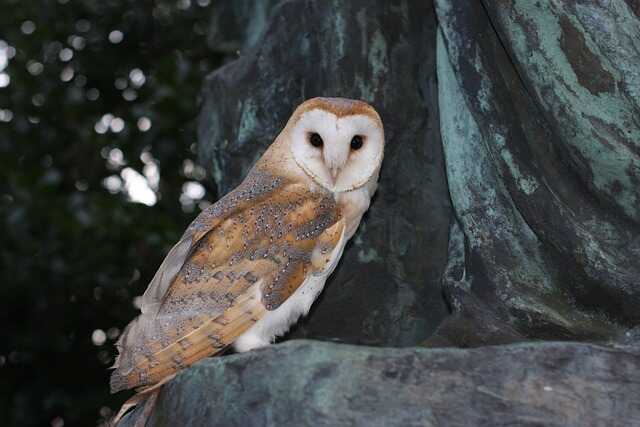
- Length: 12.6-15.8 in (32-40 cm)
- Weight: 14.1-24.7 oz (400-700 g)
- Wingspan: 39.4-49.2 in (100-125 cm)
- Scientific Name: Tyto alba
- Frequency of Occurrence: 0.6411%
- Maps: Range Map – Sightings Map
- Sounds: Calls and Songs
- Where To Find Them: The best time to observe Barn Owls in Utah is during their nesting season, which runs from late February through August. During this time, they can be seen roosting in tree cavities or hunting over open fields near areas like Provo River and Jordan Meadows Wildlife Management Area. Additionally, they nest along the banks of rivers such as the Colorado River and near farms with natural grasslands – making them easily visible to observers.
- How to Attract: Start by providing an ideal nesting spot in your yard. Barn Owls typically nest in cavities and crevices, so consider installing boxes specifically designed for them or adding some flat surfaces near trees that could double as potential nesting grounds. You can also look into planting native vegetation around your property as this will create a natural habitat and attract prey, like insects, which the owls rely on for food. Creating water sources is another great way to draw in Barn Owls – they love areas with damp conditions where they can find small frogs and fish that form part of their diet.
General Information: Barn Owls have a mysterious air about them – their nocturnal habits and big, soulful eyes draw us in. They are found on every continent except Antarctica, but where exactly do they live? The answer is quite varied! When it comes to the range of Barn Owls, these incredible birds can be found in grasslands, forests, marshes and rainforests.
There’s no shortage of habitats for them to explore! From dense jungles to open-air meadows, Barn Owls take advantage of every niche they can find. And when it comes to their diet – small mammals like mice and voles are top of the list. But they also enjoy feasting on large insects or small birds if they’re lucky enough to catch one!
Western Screech Owl
- Length: 7.5-9.8 in (19-25 cm)
- Weight: 3.5-10.8 oz (100-305 g)
- Wingspan: 21.6-24.4 in (55-62 cm)
- Scientific Name: Megascops kennicottii
- Frequency of Occurrence: 0.5127%
- Maps: Range Map – Sightings Map
- Sounds: Calls and Songs
- Where To Find Them: To start your search for this lively owl, consider visiting Zion National Park or nearby areas such as Grand Staircase-Escalante National Monument or Cedar Breaks National Monument. These parks offer great opportunities for sighting the Western Screech Owl because they have plenty of open meadows and wooded areas that these birds inhabit. You can even try scanning the trees near rivers at night because these habitats are often used by Western Screech Owls during breeding season.
- How to Attract: One of the best strategies for attracting Western Screech Owls is to provide them with shelter and nesting opportunities. Providing nest boxes will create an inviting space for the birds to set up shop in your landscape. You can also install a roost box or two to give the owls somewhere comfortable to rest during the day. Additionally, making sure they have plenty of dense vegetation and trees near their nesting sites will provide them with both food and protection from predators.
General Information: The Western Screech Owl is a small, nocturnal raptor that can be found in the western United States and parts of Canada. This secretive bird has adapted to many different habitats, from thick forests to open grasslands, making it one of the most widespread owl species in North America. They are also uniquely equipped with deep ear tufts and yellow eyes that give them an intimidating appearance.
The Western Screech Owl’s range extends from California to British Columbia and eastwards into Arizona and New Mexico. Within their range, they prefer semi-open habitats such as woodlands, farmlands or urban parks which provide plenty of shelter for roosting during the day. Their diet consists mainly of small rodents like voles and mice, but they are known to feed on insects too!
Short-eared Owl
- Length: 13.4-16.9 in (34-43 cm)
- Weight: 7.3-16.8 oz (206-475 g)
- Wingspan: 33.5-40.5 in (85-103 cm)
- Scientific Name: Asio flammeus
- Frequency of Occurrence: 0.4211%
- Maps: Range Map – Sightings Map
- Sounds: Calls and Songs
- Where To Find Them: The Great Salt Lake Desert is a prime location for spotting these rare birds. With its endless expanse of open spaces and grasslands, it’s no wonder why this owl species chooses to spend so much time here! Another great spot is Antelope Island State Park on the northern part of the lake. This area has plenty of shallow wetlands which provide ideal conditions for these owls to hunt small rodents.
- How to Attract: Creating an inviting environment for the Short-eared Owl is the first step in encouraging them to visit your backyard. Planting native shrubs, trees, and flowers will provide a habitat for rodents, which are the owl’s main food source. Additionally, adding features such as brush piles or wooded edges will also help make your area more attractive to owls since they use these elements for nesting or roosting sites. Providing water sources such as a shallow dish or bird bath is another great way of attracting owls, since they require fresh water supply while living in an urban environment.
General Information: The Short-eared Owl can be found across the globe, from Alaska in the North to South America, Africa and some parts of Europe. This majestic animal with its round facial disk, yellow eyes and distinct tufts of feathers is an iconic species that has adapted to a variety of habitats. From wetland areas and open grasslands, to deserts and tundra regions – they have made many different places their home.
They often prefer wide open spaces where they can hunt easily for small mammals like voles but sometimes will also take birds or insects as part of their diet. Short-eared Owls are highly adaptable creatures that spend much of their time on the ground looking for prey rather than perching in trees like other owls do. They are active during both day and night which makes them one of the few owl species who hunt during daylight hours!
Flammulated Owl
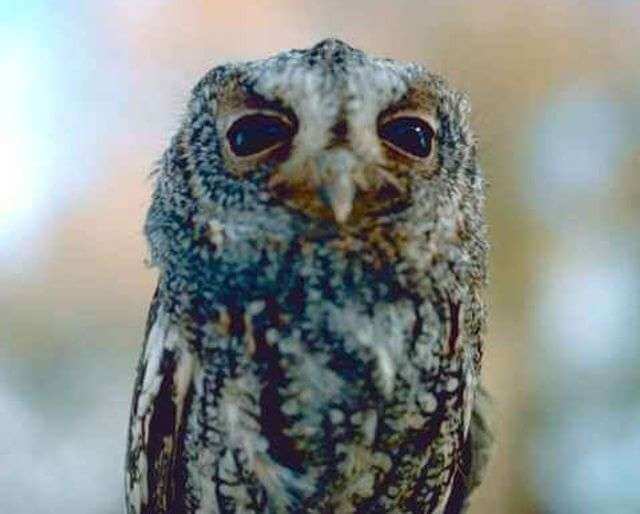
- Length: 5.9-6.7 in (15-17 cm)
- Weight: 1.5-2.2 oz (43-63 g)
- Wingspan: 15.9-16.1 in (40.5-41 cm)
- Scientific Name: Otus flammeolus
- Frequency of Occurrence: 0.2749%
- Maps: Range Map – Sightings Map
- Sounds: Calls and Songs
- Where To Find Them: Though they can be difficult to find, there are some areas in Utah where you’re more likely to encounter a Flammulated Owl. Antimony, Gifford Point, Brian Head Peak, and Red Canyon Park are all known spots for these rare little owls – so if you’re looking for an adventure this summer then why not try your luck?
- How to Attract: To attract Flammulated Owls to your yard without relying on live food sources, you’ll need to provide the right kind of habitat for them. Plant native shrubs and trees that offer sheltered nesting spots, such as juniper or oak. Create a water source near tall vegetation, so they have easy access for drinking and bathing. You should also set up nest boxes specifically designed for Flammulated Owls in order to give them an ideal spot for roosting during the day and breeding at night.
General Information: The Flammulated Owl is a small, mysterious owl with a rather unique range. These owls are found primarily in North America and Mexico, but they can also be seen in Central American countries like Guatemala. The habitat of this species is quite varied, as they favor coniferous or mixed forests with open areas such as pastures or parks. They can often be heard calling out at night while perched on low branches of trees or power lines.
When it comes to their diet, the Flammulated Owl has quite the appetite! They are mostly insectivores, preying upon moths, beetles and other nocturnal insects that come out at night. In addition to these creatures, they will occasionally feed on small rodents like mice and voles for an extra boost of energy during mating season.
Northern Pygmy Owl
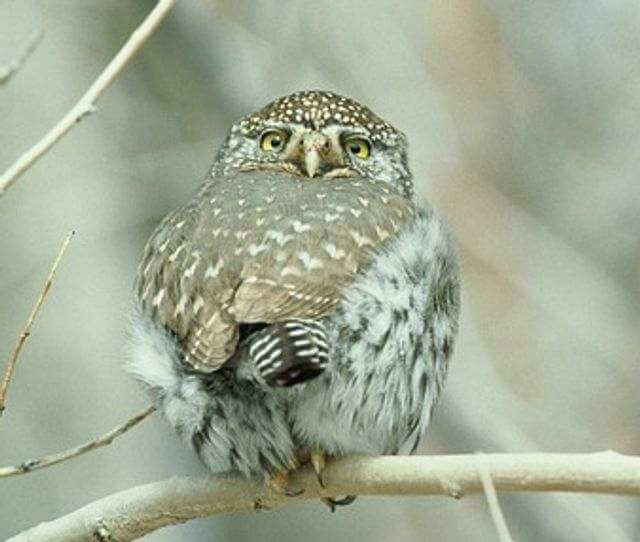
- Length: 6.7-7.5″ in. (17-19 cm)
- Weight: 2.2-2.6 oz. (62-73 g)
- Wingspan: 14 – 16″ in.
- Scientific Name: Glaucidium californicum
- Frequency of Occurrence: 0.2708%
- Maps: Range Map – Sightings Map
- Sounds: Calls and Songs
- Where To Find Them: It’s possible to see the Northern Pygmy Owl in many areas around Utah, especially during spring and summer months. During this time, they can often be spotted in northern parts of the state near forests and open woodlands, such as Dixie National Forest or Wasatch-Cache National Forest. They also like coniferous habitat; so if you visit places such as Logan Canyon or Monte Cristo Mountain Range, you may get lucky enough to catch a glimpse of one!
- How to Attract: To start, you’ll want to do some research on the habitat requirements of the Northern Pygmy Owl—such as tree cavities for nesting and ample perches for hunting—and make sure your yard meets their needs. You can also add supplementary feeders filled with seed, nuts or mealworms to ensure they have enough nutrition while they’re visiting your yard. Additionally, adding birdbaths and other water features will help them stay hydrated in between meals.
General Information: Northern Pygmy Owls are a unique species of owl, living in various parts of the world. Found mainly in North and Central America, they inhabit woodlands and shrubberies that provide them with plenty of food and shelter. These small owls have an impressive range, stretching from Alaska to Nicaragua! The Northern Pygmy Owl lives in habitats such as coniferous forests, deciduous stands, as well as riparian corridors.
They prefer to nest near trees with large cavities where they can stay safe from potential predators. When it comes to their diet, these owls typically feed on small birds and mammals such as mice or shrews. They also consume insects like grasshoppers or beetles during the summer months, when larger prey is scarce.
Northern Saw-whet Owl
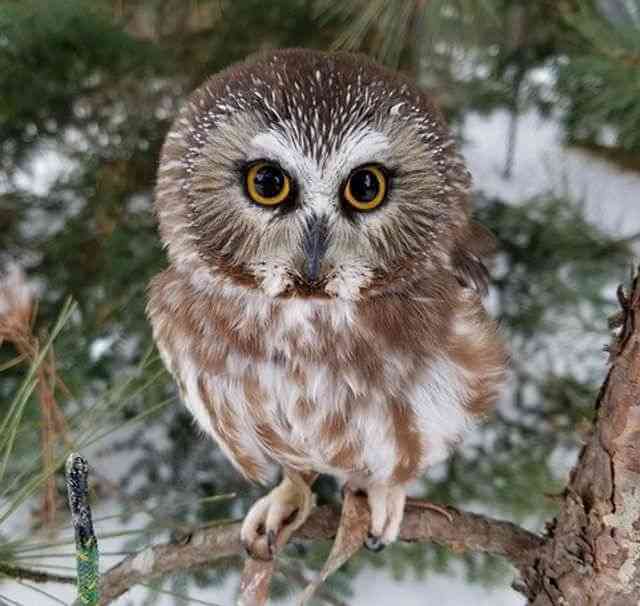
- Length: 7.1-8.3 in (18-21 cm)
- Weight: 2.3-5.3 oz (65-151 g)
- Wingspan: 16.5-18.9 in (42-48 cm)
- Scientific Name: Aegolius acadicus
- Frequency of Occurrence: 0.2020%
- Maps: Range Map – Sightings Map
- Sounds: Calls and Songs
- Where To Find Them: For those looking to find the Northern Saw-whet Owl in Utah, the Uinta Mountains are an excellent place to start. These birds are more likely to be spotted during autumn migration, when they move from Canada and Alaska down into Utah’s mountainous terrain. Other areas such as Zion National Park or Fishlake National Forest may provide better odds at spotting them year round.
- How to Attract: To attract them, start by providing plenty of mature trees with cavities or nesting boxes that offer shelter from the elements. Planting berry bushes such as serviceberry or elderberry will also provide a source of food for the owls. Additionally, avoid using pesticides and herbicides around your property; these chemicals can affect the natural food sources of the owls. Finally, make sure you keep your pet cats indoors to prevent them from hunting and scaring away any visiting owls. With a few simple steps, you’ll soon have Northern Saw-whet Owls as regular visitors to your yard!
General Information: The Northern Saw-whet Owl is a small, nocturnal owl that is native to North America. They are one of the smallest owls in the world and have adapted to live in a variety of habitats. These small yet majestic birds can be found living in woodlands, forests, and even cities! Their range extends from Northern Alaska all the way down to Mexico, allowing them to inhabit diverse environments.
During the summer months, they can be seen nesting in coniferous trees or old abandoned buildings. In winter, however, these enchanting creatures will migrate south for warmer climates and more abundant prey. Northern Saw-whet Owls feed primarily on small mammals such as voles and mice; however, they will also feast on insects, birds and amphibians when available.
Read more: What is the Smallest Owl in North America? (A Full Guide)
Long-eared Owl
- Length: 13.8-15.8 in (35-40 cm)
- Weight: 7.8-15.3 oz (220-435 g)
- Wingspan: 35.4-39.4 in (90-100 cm)
- Scientific Name: Asio otus
- Frequency of Occurrence: 0.1958%
- Maps: Range Map – Sightings Map
- Sounds: Calls and Songs
- Where To Find Them: Utah offers plenty of opportunities for birders and nature lovers alike to observe these remarkable creatures during their migration season. The northernmost reaches of the Wasatch Mountains are great places for spotting them; as well as locations near Cedar City, and Kanab. During winter months, they may also be seen around Zion National Park and along the banks of the Great Salt Lake.
- How to Attract: Attracting Long-eared Owls to your yard doesn’t have to involve live food. Instead, you can create an environment where they feel safe and comfortable. Put up a nest box for them, provide perches such as tree branches or poles, and provide plenty of dense vegetation for cover. Plant native trees that grow in the same range as the owls, as this will help give them even more natural places to hide from predators. Finally, keep outdoor cats away if possible, since they can be very dangerous threats to these birds. With a few simple steps, you can make your backyard an inviting home for Long-eared Owls!
General Information: The Long-eared Owl (Asio otus) is a mysterious and elusive creature. Native to the Northern Hemisphere, this majestic owl can be found living in diverse habitats across much of temperate Eurasia and North America. With its prominent ear tufts and distinctive yellow eyes, this nocturnal species is a sight to behold.
A highly adaptable bird, the Long-eared Owl can be found inhabiting a range of habitats including coniferous forests, deciduous woodlands, grasslands and even farm fields. It often nests in hollows or abandoned nests of other birds, such as magpies or crows. Its diet mainly consists of small mammals such as mice, voles and shrews, although it will also take smaller birds if necessary.
Spotted Owl
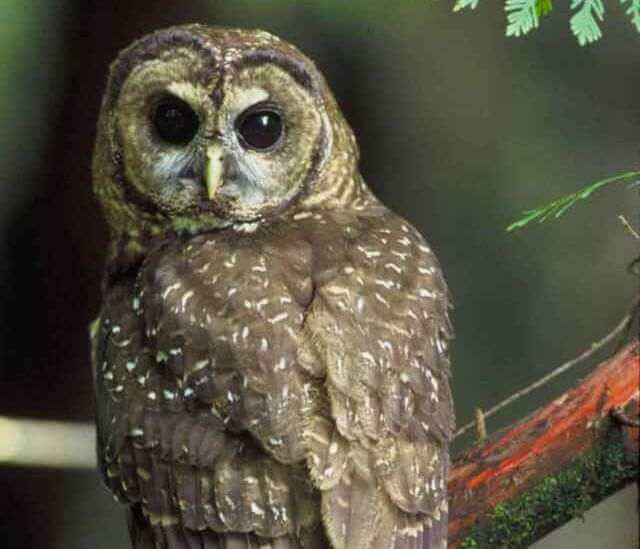
- Length: 18.5-18.9 in (47-48 cm)
- Weight: 17.6-24.7 oz. (500-700 g)
- Wingspan: 39.8 in (101 cm)
- Scientific Name: Strix occidentalis
- Frequency of Occurrence: 0.0367%
- Maps: Range Map – Sightings Map
- Sounds: Calls and Songs
- Where To Find Them: In Utah, Spotted Owls can be found mainly in the high-elevation forests of the Wasatch Mountains. Or if you’re feeling adventurous, venture into the remote regions of Zion National Park to catch a glimpse of these incredible birds.
- How to Attract: Attracting spotted owls to your yard can be a rewarding experience, but it doesn’t have to involve live food. First, provide plenty of shelter in the form of large trees and dense shrubs that can act as roost sites for the owls. Secondly, make sure there is a reliable water source nearby such as a pond or stream, which will attract other animals that the owl may prey on. Finally, use artificial nesting boxes to create a safe place where the owl can settle down and lay eggs.
General Information: The magnificent Spotted Owl is a species of owl that inhabits parts of North and Central America. This striking bird has long been admired for its distinct, spotted plumage and owlish watchfulness. Its range covers a variety of habitats stretching from the Pacific Northwest all the way to Central Mexico. Spotted Owls prefer densely wooded areas with plenty of old growth forests, but they are also known to inhabit riparian corridors, open woodlands and even deserts.
They usually hunt small mammals, such as bats and voles, but can also be seen dining on amphibians and reptiles when they step out of their comfort zone. No matter what it is hunting for dinner, the enchanting Spotted Owl will certainly captivate any wildlife enthusiast who comes across one in its natural habitat!
Great Gray Owl
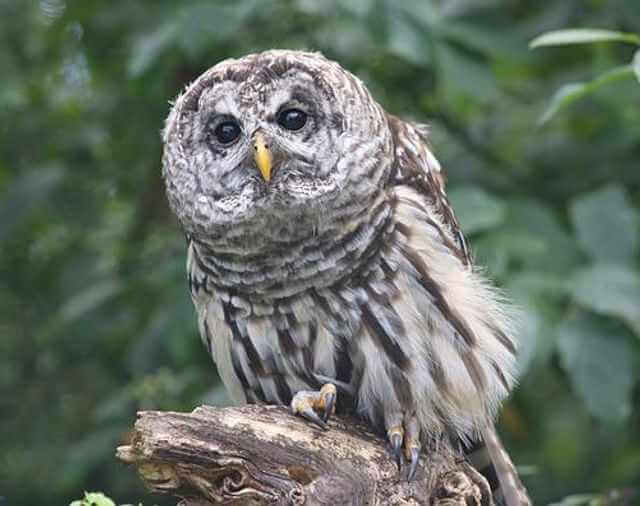
- Length: 24.0-33.1 in (61-84 cm)
- Weight: 24.7-60.0 oz (700-1700 g)
- Wingspan: 53.9-60.2 in (137-153 cm)
- Scientific Name: Strix nebulosa
- Frequency of Occurrence: 0.0252%
- Maps: Range Map – Sightings Map
- Sounds: Calls and Songs
- Where To Find Them: Utah is home to some of the best spots for seeing these owls in action. You can find them nesting around areas with dense forests near Cache Valley or near Logan Canyon—both great places to watch these owls soar through the sky. In addition, keep your eye out for flyovers, as they tend to hunt over high mountain ridges or open fields. Keep your binoculars handy, so you don’t miss out on any sightings!
- How to Attract: To start, a standing dead tree or large snag will make an ideal perch for an owl – especially if it’s in an open area with minimal cover from vegetation. Additionally, areas with plenty of small mammals like mice and voles that the owl can feed off will increase the chances of spotting one. Also consider providing nesting materials such as a nestbox wood chips or sawdust near where you want to attract the owl – this will make them feel more at home and encourage them to stay nearby. Finally, be patient!
General Information: The mysterious Great Gray Owl is a beloved species to birdwatchers and nature enthusiasts alike. This majestic raptor, with its haunting yellow eyes, has become a symbol of the wild for many. With its wide range and diverse habitats, the Great Gray Owl presents itself as an impressive subject of study. This magnificent owl can be found in North America across Canada, Alaska and northern United States stretching into Mexico.
It prefers areas of dense coniferous forests such as boreal forests, pine-oak woodlands and western mountain meadows but can also inhabit taiga or tundra environments where it feeds on voles, lemmings and small rabbits. Its diet may also consist of other mammals like shrews, mice or squirrels as well as amphibians like frogs while they have even been seen eating reptiles such as snakes!
Read more: 53 Fun Facts About The Great Gray Owl (Photos, ID & Info)
Boreal Owl
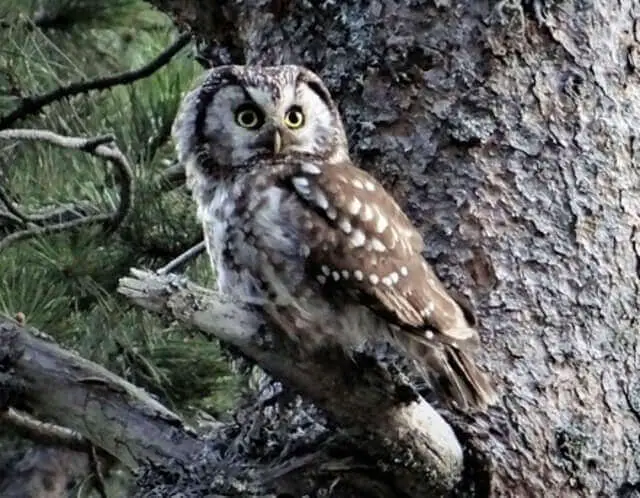
- Length: 8.3-11.0 in (21-28 cm)
- Weight: 3.3-7.6 oz (93-215 g)
- Wingspan: 21.6-24.4 in (55-62 cm)
- Scientific Name: Aegolius funereus
- Frequency of Occurrence: 0.0102%
- Maps: Range Map – Sightings Map
- Sounds: Calls and Songs
- Where To Find Them: The best time to see the Boreal Owl is during late fall and winter, when they migrate south from Canada and Alaska. They generally prefer coniferous forests located at higher elevations; areas surrounding Logan Canyon tend to be popular spots for seeing these owls due to the abundance of spruce-fir trees there. Another notable location is Kolob Canyon Road, which makes for an ideal lookout point since it offers sweeping views of the surrounding landscape below.
- How to Attract: First and foremost, you need to make sure that your backyard is the kind of environment where these majestic birds will feel comfortable. Planting evergreens such as spruces or pines can provide the perfect habitat for them. Additionally, be sure to add bird feeders filled with high-fat seeds and suet, which also act as great natural lures for the Boreal Owl. Once you have made your backyard owl-friendly, consider setting up an artificial nest box in a tree or on a pole. This should be placed at least seven feet off of the ground in order to provide safety from predators.
General Information: The Boreal Owl is a majestic bird that has adapted to survive in some of the harshest climates on earth. From its range of habitats spanning from North America to Asia, this feathered creature can be found with ease in some of the most unique and stunning regions around the world. This owl species prefers coniferous forests but can also thrive in mixed woodlands, wetlands and even suburban areas.
They typically build their nests out of old woodpecker holes or abandoned squirrel dens, making them excellent tenants for nature reserves. Furthermore, they often feed upon small mammals such as voles and mice, as well as birds and insects when available. During colder months, these birds may even hunt during daylight hours due to the lack of nocturnal prey items!
Snowy Owl
- Length: 20.5-27.9 in (52-71 cm)
- Weight: 56.4-104.1 oz (1600-2950 g)
- Wingspan: 49.6-57.1 in (126-145 cm)
- Scientific Name: Bubo scandiacus
- Frequency of Occurrence: 0.0053%
- Maps: Range Map – Sightings Map
- Sounds: Calls and Songs
- Where To Find Them: For those interested in spotting Snowy Owls in Utah, one of the best places to look is Bear River Migratory Bird Refuge. This sprawling wildlife preserve near Brigham City offers many opportunities to observe these spectacular creatures while they search for food and raise their young. In addition, nearby wetlands provide perfect habitats for these owls due to the abundance of small mammals that inhabit such areas. Another great spot for viewing Snowy Owls is Flaming Gorge National Recreation Area.
- How to Attract: To start, it’s important that you provide a habitat for them. Place plenty of birdhouses throughout your property and make sure they are situated away from any disturbance or danger. Plant native shrubs and trees that will provide shelter as well as help create nesting sites for the owl. Additionally, leaving out logs and stumps in open areas provides perching spots for these majestic birds. Finally, be sure to keep your yard free from any human activity or loud noises that could chase away potential feathered friends!
General Information: The Snowy Owl is a magnificent creature, native to the Arctic Circle. These beautiful birds of prey are as white as freshly fallen snow and have piercing yellow eyes that can spot their prey from incredible distances. But these owls aren’t just stunningly gorgeous – they make for tough and competent hunters! Their range is wide, stretching across Canada and Alaska all the way down to some parts of California.
And when it comes to habitats, Snowy Owls have been known to take up residence in open tundra regions or barren fields where they can more easily find food sources such as lemmings, voles, hares, fish and even seabirds! They also feed on carrion if needed. These powerful birds use their sharp talons to capture their victims with ease.
Read more: 48 Fun Facts About Snowy Owls (Full Guide with Photos!)
Elf Owl
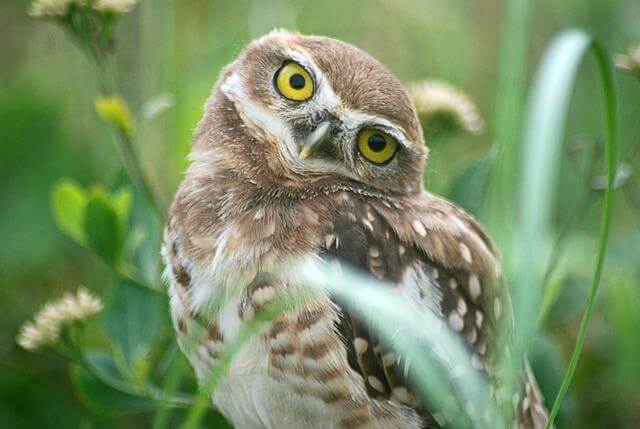
- Length: 4.7-5.5 in (12-14 cm)
- Weight: 1.2-1.9 oz. (35-55 g)
- Wingspan: 13.0 in (33 cm)
- Scientific Name: Micrathene whitneyi
- Frequency of Occurrence: 0.0021%
- Maps: Range Map – Sightings Map
- Sounds: Calls and Songs
- Where To Find Them: If you’re looking to spot an Elf Owl while in Utah, you should head south to the state’s desert regions. There have been sightings as far north as Salt Lake City and Provo, but they prefer dry climates with plenty of cacti for snacking on scorpions and insects. In addition to deserts like Capitol Reef National Park and Zion National Park, look for them near arid washes or along canyon rims. They can even sometimes be seen perched atop telephone poles near rural towns!
- How to Attract: If you’re looking for a fun way to bring the Elf Owl into your life without having to purchase live food or build a costly enclosure, there are several ways you can get creative. Consider setting up birdhouses specifically designed for the Elf Owl—these structures provide a safe place for them to rest. Additionally, consider planting certain trees and shrubs near your home that will be attractive nesting spots for the owls. Fruiting plants such as pyracantha shrubs are particularly beneficial as they supply both shelter and nourishment in one spot!
General Information: The Elf Owl is an astonishingly small bird that has a surprisingly vast range. Native to areas from the southwestern United States to Central America, these multifaceted creatures can be found in numerous habitats. Whether it’s inhabiting deserts, woodlands, grasslands or mountain forests, the Elf Owl lives up to its nocturnal name and is often spotted during twilight hours.
Measuring in at only five inches tall and weighing around 1.4 ounces, this diminutive owl is one of the smallest birds of prey in North America. Its unique diet consists of insects, spiders and scorpions; however, it will also eat fruit and berries when available. The Elf Owl isn’t picky about where it sets up shop either – nesting takes place within holes abandoned by other birds, as well as inside cactus plants!
Related Post: 53 Most Common Backyard Birds In Utah 2023 (Full Guide)

